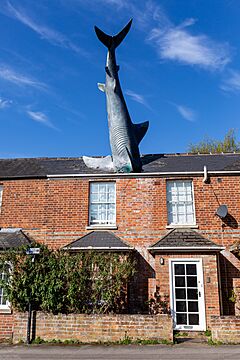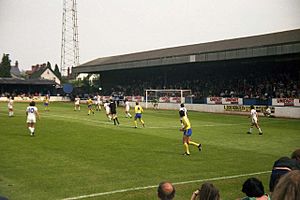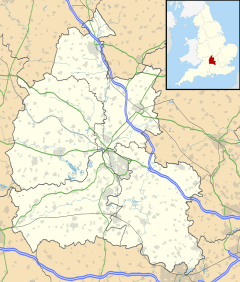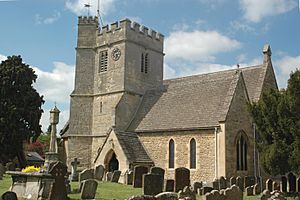Headington facts for kids
Quick facts for kids Headington |
|
|---|---|
 The Headington Shark |
|
| OS grid reference | SP5407 |
| Civil parish |
|
| District | |
| Shire county | |
| Region | |
| Country | England |
| Sovereign state | United Kingdom |
| Post town | Oxford |
| Postcode district | OX3 |
| Dialling code | 01865 |
| Police | Thames Valley |
| Fire | Oxfordshire |
| Ambulance | South Central |
| EU Parliament | South East England |
| UK Parliament | |
| Website | www.headington.org.uk |
Headington is a lively area located on the eastern side of Oxford, a famous city in England. It sits on top of Headington Hill, giving it great views over the city below. Headington is surrounded by other places like Marston, Cowley, Barton, and Risinghurst. The main street, London Road, is super important here, connecting London and Oxford.
Contents
A Look Back in Time: Headington's History
Headington has been home to people for a very long time! Archaeologists have found signs of people living here since the Stone Age, over 3,000 years ago. They even found pottery from the British Iron Age (around 700 BC).
Ancient Discoveries in Headington
Later, around the year 300, Roman pottery ovens were discovered. One of these ovens is now on display at the Museum of Oxford. Even older remains from the Anglo-Saxon period (around 500 AD) have been found too.
The name "Headington" comes from an old English phrase, Hedena's dun, which means "Hedena's hill". Long ago, it might have been a special palace or hunting lodge for the Kings of Mercia. In the year 1004, King Æthelred the Unready gave land in Headington to St Frideswide's Priory, which included a quarry.
Churches and Growth
In 1122, King Henry I gave a chapel in Headington to the Augustinian monks of St Frideswide's Priory. The local church, Saint Andrew's, was built in the mid-1100s and made bigger in the 1200s. Its tall bell tower was finished around 1500. The church has been repaired many times over the centuries.
Headington grew very quickly in the early 1900s. Many new houses were built around the old village, which is now called Old Headington. In 1929, Headington became part of the city of Oxford. New Headington is a newer part of the area, built in the late 1800s. Other parts of modern Headington include Highfield, Quarry, and Headington Hill.
The City of Oxford Silver Band actually started as the Headington Brass Band way back in the 1800s!
Headington Today: A Busy Community
Headington is a large and growing place with many people living there. The main jobs in Headington are in medicine, education, and research.
Local Life and Landmarks
In the center of Headington, you'll find lots of shops, pubs, cafés, and restaurants. It's also home to the main campus of Oxford Brookes University and Ruskin College. Plus, Oxford's main hospitals, like the John Radcliffe, Nuffield, and Churchill, are located here.
Headington's most famous modern landmark is The Headington Shark. This cool sculpture was made by John Buckley in 1986 for a local person named Bill Heine.
Green Spaces and Nature
Headington has many lovely green spaces for everyone to enjoy. These include Headington Hill Park, Bury Knowle Park, and South Park. Nearby, you can explore Shotover Hill, which has heathland and woodlands with amazing views over Oxfordshire. It's even a special protected area for nature! The Warneford Meadow, a wild grassland, was bought by the public in 1918 and is now a protected Town Green.
Sports and Fun in Headington
Headington has a strong connection to sports!
Football History
The famous football team Oxford United started in Headington in 1893 as Headington F.C. They added "United" in 1911 after joining with another team. Until 2001, their home stadium was the Manor Ground, which was right off London Road. Oxford United later moved to a new stadium. The old Manor Ground has since been replaced by a hospital. Headington also has its own local football team, Headington Amateurs, who play at the Barton Recreation Ground.

Famous People Who Lived in Headington
Many interesting people have called Headington home over the years:
- Brian Aldiss, a well-known science fiction writer, lived in Old Headington.
- Joan Clarke Murray, who helped break the Enigma code during World War II, lived here.
- Elizabeth Jennings, a famous poet, spent her later years in Headington.
- C. S. Lewis, the author of The Chronicles of Narnia, lived in Headington for many years. He is buried nearby.
- John Simpson, a senior editor of the Oxford English Dictionary, was a resident.
- J. R. R. Tolkien, the amazing author of The Hobbit and The Lord of the Rings, lived in Headington from 1953 to 1968.
- Emma Watson, who played Hermione Granger in the Harry Potter films, lived in Headington and went to Headington School.
Many professors and important people from Oxford University have also lived in Headington. These include Lord Krebs, David Marquand, Sir Isaiah Berlin, and Lord Nuffield (William Morris), who was a very important businessman.




